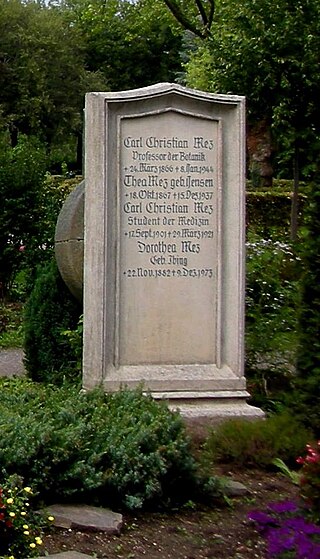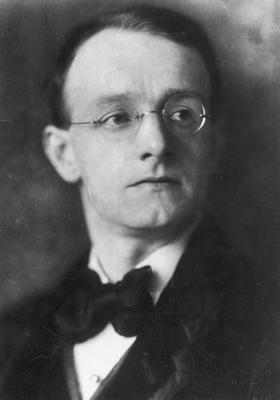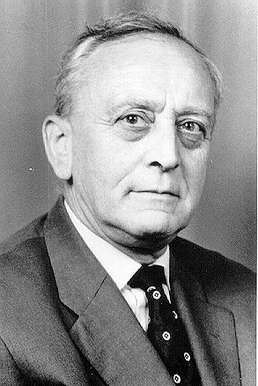Related Research Articles

Edmund Georg Hermann Landau was a German mathematician who worked in the fields of number theory and complex analysis.

(Chaim) Herman Müntz was a German mathematician, now remembered for the Müntz approximation theorem.

Robert Wichard Pohl was a German physicist at the University of Göttingen. Nevill Francis Mott described him as the "father of solid state physics".
Karl Mey was a prominent German industrial physicist who directed the research and development branch of Osram AG. His presidency of the Deutsche Physikalische Gesellschaft, starting the year Hitler became Chancellor of Germany, was crucial in that organization's ability to assert its independence from National Socialist policies.

Carl Christian Mez was a German botanist and university professor. He is denoted by the author abbreviation Mez when citing a botanical name.
Rudolf Karl Anton Tomaschek was a German experimental physicist. His scientific efforts included work on phosphorescence, fluorescence, and (tidal) gravitation. Tomaschek was a supporter of deutsche Physik, which resulted in his suspension from his university posts after World War II. From 1948 to 1954, he worked in England for the Anglo-Iranian Oil Company (AIOC). In 1954, when AIOC became BP, he went to Germany and was president of the Permanent Tidal Commission.
Wilhelm Orthmann was a German physicist. He was director of the physico-technical department of the Industrial College of Berlin. During World War II, he was also employed by the Reich Aviation Ministry.
Herbert Arthur Stuart was a German experimental physicist who made contributions in molecular physics research. During World War II, he was director of the experimental physics department at the Technische Hochschule Dresden. From 1955, he was the head of the high polymer physics laboratory at the University of Mainz.
Gerhard Kowalewski was a German mathematician who introduced the matrices notation.

Eberhard Fraas was a German scientist, geologist and paleontologist. He worked as a curator at the Stuttgarter Naturaliensammlung and discovered the dinosaurs of the Tendaguru formation in then German East Africa. The dinosaur Efraasia is named after him.
Otfrid Mittmann was a German mathematician. Starting in 1927, he studied mathematics and natural sciences in Göttingen and Leipzig, and got his Ph.D. in Apr 1935. He joined the Nazi movement in Oct 1929. and published on statistical aspects of Nazi eugenics. After the war, he published in Göttingen and Bonn.

Fidelio Friedrich "Fritz" Finke was a Bohemian-German composer.
Eberhard Büchner is a German operatic and concert tenor. He made his debut in 1964 as Tamino in Mozart's Die Zauberflöte at the Mecklenburg State Theatre.
Friedrich Geiger is a German musicologist.
Martin Krause was a German mathematician, specializing in analysis.

Friedrich Gustav von der Leyen was a German philologist who specialized in Germanic studies.

Wolfgang Golther was a German philologist who specialized in Germanic studies. A professor at the University of Rostock, Golther was a prominent authority on Medieval German literature and Germanic religion.
Wilhelm Emil Mühlmann was a German ethnologist who served as Professor of Ethnology at the University of Mainz and Chair of Ethnology at the University of Heidelberg.

Richard von Kienle was a German linguist who specialized in Germanic and Indo-European linguistics.

Eberhard Hermann Erich Zeidler was a German mathematician, who worked primarily in the field of non-linear functional analysis.
References
- ↑ E. Melchior (1940), Über Vielseite der Projektive Ebene. Deutsche Math. volume 5, pages 461–475
- ↑ Eberhard Melchior (1937), Untersuchungen über ein Problem aus der Theorie der Konfigurationen. Ph.D. thesis, Berlin University.
- ↑ Eberhard Melchior's entry in the Mathematics Genealogy Project at University of North Dakota. Accessed on 2009-12-30.
- ↑ Eberhard Melchior [ permanent dead link ] entries in the Deutsche Mathematiker Vereinung database